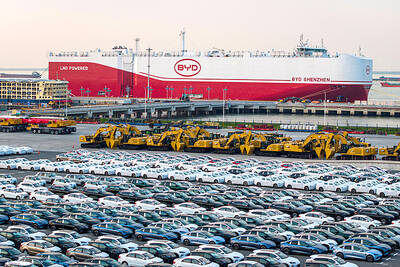Carbon capture techniques will continue to be a top priority for Taiwan Cement Corp’s (台灣水泥) Hualien-based subsidiary Ho-Ping Power Co (和平電廠), chairman Nelson Chang (張安平) said yesterday at a news conference in Hualien, citing reductions in production costs and new business potential for growing microalgae as benefits.
Taiwan Cement, the nation’s largest cement maker, has since 2011 been involved in a carbon capture project at Ho-Ping Power through collaborations with the Industrial Technology Research Institute (ITRI, 工研院) since 2011. The project aims to reduce carbon dioxide emissions and promote a circular economy.
PILOT PLANT
The pilot plant at Ho-Ping Power is the world’s largest facility to employ the calcium looping process for carbon capture, the company said.
The calcium looping capture process uses calcium oxide, a common ingredient in cement products, as a sorbent for carbon dioxide and could reduce the carbon dioxide capture cost from more than US$45 per tonne to US$30 per tonne, the company said.
Taiwan Cement and ITRI last year signed an agreement to extend their technical cooperation on the project.
The pilot production lines are likely to begin commercial operations before 2022, Chang said, citing difficulty scaling up the project.
The firm has allocated a capital budget of nearly NT$70 million (US$2.3 million) to the technique in the past few years and plans to spend NT$10 million per year in the future.
Apart from lowering production costs, carbon capture technology also turned out to have unexpected business potential after the company found that captured carbon dioxide could be used to grow microalgae.
MICROALGAE
Microalgae — a major source of biofuel — can also produce astaxanthin, a key ingredient in high-value skincare products and medicines.
Taiwan Cement said it is seeking business partners to promote skincare uses for astaxanthin, instead of launching its own brand.
The company needs to stay focused on its core business and has no plans to tap into the retailing industry, Chang told the Taipei Times.
Taiwan Cement’s long-term goal was to transform itself from a traditional cement maker into a “green” service provider, the company said.
Revenue generated by the company’s two major energy subsidiaries, Ho-Ping Power and Moli Energy Corp (能元科技), made up nearly 15 percent of Taiwan Cement’s total sales last year, while its cement business contributed 73 percent, data showed.
‘GREEN ENERGY’
Meanwhile, the company plans to launch a large-scale “green” energy project at the Changhua Coastal Industrial Park (彰濱工業區), Chang said.
He declined to provide details on the new project, saying only that it is to include wind power generation.
Many companies put their unused factories up for sale, but the company hopes to “revitalize” its abandoned facilities, Chang said.

Micron Memory Taiwan Co (台灣美光), a subsidiary of US memorychip maker Micron Technology Inc, has been granted a NT$4.7 billion (US$149.5 million) subsidy under the Ministry of Economic Affairs A+ Corporate Innovation and R&D Enhancement program, the ministry said yesterday. The US memorychip maker’s program aims to back the development of high-performance and high-bandwidth memory chips with a total budget of NT$11.75 billion, the ministry said. Aside from the government funding, Micron is to inject the remaining investment of NT$7.06 billion as the company applied to participate the government’s Global Innovation Partnership Program to deepen technology cooperation, a ministry official told the

Taiwan Semiconductor Manufacturing Co (TSMC, 台積電), the world’s leading advanced chipmaker, officially began volume production of its 2-nanometer chips in the fourth quarter of this year, according to a recent update on the company’s Web site. The low-key announcement confirms that TSMC, the go-to chipmaker for artificial intelligence (AI) hardware providers Nvidia Corp and iPhone maker Apple Inc, met its original roadmap for the next-generation technology. Production is currently centered at Fab 22 in Kaohsiung, utilizing the company’s first-generation nanosheet transistor technology. The new architecture achieves “full-node strides in performance and power consumption,” TSMC said. The company described the 2nm process as

Shares in Taiwan closed at a new high yesterday, the first trading day of the new year, as contract chipmaker Taiwan Semiconductor Manufacturing Co (TSMC, 台積電) continued to break records amid an artificial intelligence (AI) boom, dealers said. The TAIEX closed up 386.21 points, or 1.33 percent, at 29,349.81, with turnover totaling NT$648.844 billion (US$20.65 billion). “Judging from a stronger Taiwan dollar against the US dollar, I think foreign institutional investors returned from the holidays and brought funds into the local market,” Concord Securities Co (康和證券) analyst Kerry Huang (黃志祺) said. “Foreign investors just rebuilt their positions with TSMC as their top target,

POTENTIAL demand: Tesla’s chance of reclaiming its leadership in EVs seems uncertain, but breakthrough in full self-driving could help boost sales, an analyst said Chinese auto giant BYD Co (比亞迪) is poised to surpass Tesla Inc as the world’s biggest electric vehicle (EV) company in annual sales. The two groups are expected to soon publish their final figures for this year, and based on sales data so far this year, there is almost no chance the US company led by CEO Elon Musk would retain its leadership position. As of the end of last month, BYD, which also produces hybrid vehicles, had sold 2.07 million EVs. Tesla, for its part, had sold 1.22 million by the end of September. Tesla’s September figures included a one-time boost in